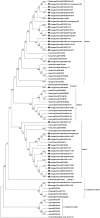Ecology of the Tick-Borne Phlebovirus Causing Severe Fever with Thrombocytopenia Syndrome in an Endemic Area of China
- PMID: 27035712
- PMCID: PMC4818090
- DOI: 10.1371/journal.pntd.0004574
Ecology of the Tick-Borne Phlebovirus Causing Severe Fever with Thrombocytopenia Syndrome in an Endemic Area of China
Abstract
Background: Severe fever with thrombocytopenia syndrome (SFTS) is caused by SFTS virus (SFTSV), a tick-borne phlebovirus in family Bunyaviridae. Studies have found that humans, domestic and wildlife animals can be infected by SFTSV. However, the viral ecology, circulation, and transmission remain largely unknown.
Methodology/principal findings: Sixty seven human SFTS cases were reported and confirmed by virus isolation or immunofluorescence assay between 2011 and 2014. In 2013-2014 we collected 9,984 ticks from either vegetation or small wild mammals in the endemic area in Jiangsu, China, and detected SFTSV-RNA by real-time RT-PCR in both questing and feeding Haemaphysalis longicornis and H. flava. Viral RNA was identified in larvae of H. longicornis prior to a first blood meal, which has never been confirmed previously in nature. SFTSV-RNA and antibodies were also detected by RT-PCR and ELISA, respectively, in wild mammals including Erinaceus europaeus and Sorex araneus. A live SFTSV was isolated from Erinaceus europaeus captured during the off tick-feeding season and with a high SFTSV antibody titer. Furthermore, SFTSV antibodies were detected in the migratory birds Anser cygnoides and Streptopelia chinensis using ELISA.
Conclusions/significance: The detection of SFTSV-RNA in non-engorged larvae indicated that vertical transmission of SFTSV in H. longicornis might occur in nature, which suggests that H. longicornis is a putative reservoir host of SFTSV. Small wild mammals such as Erinaceus europaeus and Sorex araneus could be infected by SFTSV and may serve as natural amplifying hosts. Our data unveiled that wild birds could be infected with SFTSV or carry SFTSV-infected ticks and thus might contribute to the long-distance spread of SFTSV via migratory flyways. These findings provide novel insights for understanding SFTSV ecology, reservoir hosts, and transmission in nature and will help develop new measures in preventing its rapid spread both regionally and globally.
Conflict of interest statement
The authors have declared that no competing interests exist.
Figures


Similar articles
-
Haemaphysalis longicornis Ticks as Reservoir and Vector of Severe Fever with Thrombocytopenia Syndrome Virus in China.Emerg Infect Dis. 2015 Oct;21(10):1770-6. doi: 10.3201/eid2110.150126. Emerg Infect Dis. 2015. PMID: 26402039 Free PMC article.
-
Phylogenetic Analysis of Severe Fever with Thrombocytopenia Syndrome Virus in South Korea and Migratory Bird Routes Between China, South Korea, and Japan.Am J Trop Med Hyg. 2015 Sep;93(3):468-74. doi: 10.4269/ajtmh.15-0047. Epub 2015 Jun 1. Am J Trop Med Hyg. 2015. PMID: 26033016 Free PMC article.
-
SFTS virus in ticks in an endemic area of China.Am J Trop Med Hyg. 2015 Apr;92(4):684-9. doi: 10.4269/ajtmh.14-0008. Epub 2015 Feb 23. Am J Trop Med Hyg. 2015. PMID: 25711611 Free PMC article.
-
An emerging hemorrhagic fever in China caused by a novel bunyavirus SFTSV.Sci China Life Sci. 2013 Aug;56(8):697-700. doi: 10.1007/s11427-013-4518-9. Epub 2013 Aug 7. Sci China Life Sci. 2013. PMID: 23917841 Review.
-
Severe fever with thrombocytopenia syndrome and its pathogen SFTSV.Microbes Infect. 2015 Feb;17(2):149-54. doi: 10.1016/j.micinf.2014.12.002. Epub 2014 Dec 11. Microbes Infect. 2015. PMID: 25498868 Review.
Cited by
-
Severe fever with thrombocytopenia syndrome (SFTS) in Thailand: using a one health approach to respond to novel zoonosis and its implications in clinical practice.One Health Outlook. 2024 Oct 1;6(1):18. doi: 10.1186/s42522-024-00112-w. One Health Outlook. 2024. PMID: 39350294 Free PMC article.
-
Inhibition of SFTSV replication in humanized mice by a subcutaneously administered anti-PD1 nanobody.EMBO Mol Med. 2024 Mar;16(3):575-595. doi: 10.1038/s44321-024-00026-0. Epub 2024 Feb 16. EMBO Mol Med. 2024. PMID: 38366162 Free PMC article.
-
Epidemiology, clinical characteristics, and treatment of severe fever with thrombocytopenia syndrome.Infect Med (Beijing). 2022 Jan 1;1(1):40-49. doi: 10.1016/j.imj.2021.10.001. eCollection 2022 Mar. Infect Med (Beijing). 2022. PMID: 38074982 Free PMC article. Review.
-
Emerging Tick-Borne Dabie bandavirus: Virology, Epidemiology, and Prevention.Microorganisms. 2023 Sep 13;11(9):2309. doi: 10.3390/microorganisms11092309. Microorganisms. 2023. PMID: 37764153 Free PMC article. Review.
-
Genome-informed investigation of the molecular evolution and genetic reassortment of severe fever with thrombocytopenia syndrome virus.PLoS Negl Trop Dis. 2023 Sep 15;17(9):e0011630. doi: 10.1371/journal.pntd.0011630. eCollection 2023 Sep. PLoS Negl Trop Dis. 2023. PMID: 37713429 Free PMC article.
References
-
- Li Y, Zhou H, Mu D, Yin W, Yu H (2015) [Epidemiological analysis on severe fever with thrombocytopenia syndrome under the national surveillance data from 2011 to 2014, China]. Zhonghua Liu Xing Bing Xue Za Zhi 36: 598–602. - PubMed
Publication types
MeSH terms
Substances
Grants and funding
LinkOut - more resources
Full Text Sources
Other Literature Sources

